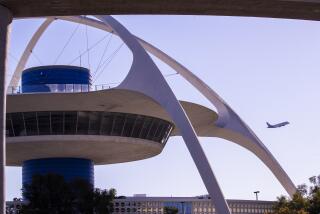Warning Not Required on Ill-Fated Takeoff : Aviation: Investigator says FAA employee did not have to tell pilot he was taking off in the direction of a mountain. Ten died in the private jet crash.
- Share via
An FAA employee who gave departure instructions to the pilot of an executive jet that crashed on Otay Mountain last month knew the plane was taking off toward the mountain but was not required to warn the pilot, a federal investigator said Monday.
A Federal Aviation Administration transcript of conversations between the pilot, Don Holms, and the unknown employee shows that neither Holms, who was departing at night under visual flight rules, nor the FAA worker mentioned the mountain.
But federal aviation regulations did not require the employee, whose job title is flight control specialist, to tell the pilot he would be heading toward a mountain, said National Transportation Safety Board investigator Richard Childress. FAA officials have refused to identify the specialist or make the employee available to the press.
It was Holms’ responsibility to be aware of the 3,572-foot high mountain, said Childress, because he was taking off from Brown Field Airport under visual flight rules. The FAA employee did nothing wrong by not telling Holms of the mountain, which is located about 10 miles east of the airport, Childress said.
A twin-engine Hawker Siddeley aircraft piloted by Holms slammed into Otay Mountain at 1:43 a.m. March 16. Holms, a co-pilot and eight members of country singer Reba McEntire’s band died in the crash. The doomed jet only missed clearing the ridge it hit by about 172 feet, investigators said.
As a flight control specialist, the FAA worker was responsible for duties such as filing pilots’ flight plans and giving weather briefings. Federal regulations also require a specialist to be familiar with “areas around local airports,” including any possible obstacles, Childress said.
Because he decided to take off under visual flight rules, it was Holms’ responsibility to be aware of any obstacles around Brown Field, Childress added.
The FAA employee who gave departure instructions to Holms was working out of Montgomery Field, about 20 miles north of Brown Field.
Last week, Roger Woolsey, an owner of the Texas company that chartered the Hawker Siddeley, complained that the specialist should have warned Holms about the mountain, particularly after approving a heading at less than 3,000 feet. The jet was airborne for less than three minutes before it crashed.
The transcript revealed that, before he took off, Holms told the FAA employee that he was taking off toward the east, where Otay Mountain is. The pilot told the specialist that he would head northeast after takeoff and stay below 3,000 feet.
“Yeah, sure. That’ll be fine,” answered the specialist.
But, Childress said, “As far as I can determine, the flight service specialist didn’t do anything that he wasn’t supposed to do.”
The investigator also said an FAA air traffic controller in San Diego and a controller at North Island Naval Air Station in Coronado picked up the plane’s brief flight on their radar screens. However, Childress said, the controllers might not have been able to warn Holms that he was flying toward the mountain.
“I will not speculate. When you’re sitting there at North Island there are a lot of things that a controller is looking at. As to how close or far away from a mountain a guy is flying, you may not even know a mountain is there if you’re inside a radar facility. The controllers (FAA and North Island) did nothing wrong,” said Childress.
The transcript released by the FAA last week also showed that Holms and the flight control specialist had three confusing conversations over departure instructions. However, Childress said the confusion “didn’t have anything to do with it (the crash) whatsoever.”
More to Read
Sign up for Essential California
The most important California stories and recommendations in your inbox every morning.
You may occasionally receive promotional content from the Los Angeles Times.













